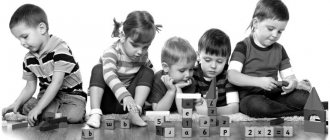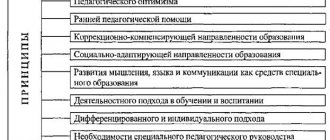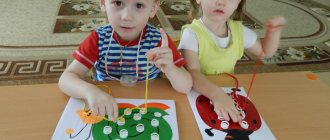Mental retardation (MDD) is a slowdown in the rate of mental development, as a result of which the cognitive (cognitive) functions (memory, perception, attention, thinking) and the emotional-volitional sphere of the child significantly lag behind accepted age norms.
Today, mental retardation is not a medical diagnosis, but is used as a psychological and pedagogical concept of a descriptive nature, which does not indicate the causes of certain disorders, but only denotes the developmental problems the child has. The term is applicable only to children of preschool and primary school age (up to 10 years). At an older age, if necessary, the child is given a specific diagnosis.
In early childhood, mental retardation is most often not noticeable. The diagnosis of mental retardation is made when the child reaches 4-5 years of age. As a rule, teachers of middle and senior groups of kindergartens are the first to sound the alarm; they pay attention to the fact that the child has to explain the same thing many times, it is difficult to interest him, he is distracted a lot, etc. Often parents do not attach much importance to these signals and do not show their child to a specialist, assuming that these are passing age-related difficulties that can simply be “outgrown.” In this case, mental retardation becomes much more noticeable when the child enters school (due to problems with academic performance). The child has difficulty mastering educational material; he finds it more interesting to play (but role-playing games are too difficult for him); engaging in intellectual activity does not attract him (he quickly gets tired of it); he has a very limited stock of general knowledge, etc.
In addition to learning difficulties, many children with mental retardation have problems with discipline. Both in the kindergarten and at school they are often reprimanded for bad behavior. The fact is that it is difficult for such children to get used to kindergarten, school, and the team in general, they are very homesick, it is difficult for them to understand that there are certain generally accepted rules of behavior and they need to learn to follow them.
How does mental retardation manifest?
With developmental retardation, the following are delayed:
- all forms of thinking - comparison, abstraction, generalization, analysis and synthesis, mental activity is reduced;
- memory - visual material is better perceived, it is difficult to remember information by ear. The memory of children with mental retardation is poorly developed - they have difficulty remembering instructions, it is difficult for them to retell a text or repeat a task;
- perception - such children need much more time to process information than their peers. It is difficult for them to form an idea of the world around them, to imagine quantities (length, width, volume), they have a low level of orientation and research activity, spatial perception is reduced, they experience difficulties in forming a holistic image of an object;
- emotional-volitional sphere - characterized by infantilism, emotional instability, excitability, difficulties with organizing one’s activities;
- attention - it is difficult for a child to concentrate, concentrate, or listen to a question or task to the end. He interrupts, starts answering ahead of time, finds it difficult to sit still, is too “loud”, impulsive, impatient, uncollected. During lessons he is often distracted and perceives information partially (fragmented attention).
It is difficult for a child with mental retardation to navigate in space; he will not be able to find a thing if he does not initially know where it is, even if it is in the most visible place. It is also difficult for such children to identify an object by touch, remember what it looks like, and talk about it from memory.
With mental retardation, children often experience low speech activity and delayed speech development (ZRD, ZPRD). Their vocabulary is poor, does not correspond to age standards, phonemic hearing is poorly developed, speech is not formed, statements are primitive and unfocused, they often confuse, omit or replace sounds and letters in words (paraphasia).
“Learning 10 words” by A.R. Luria.
Purpose: the technique allows you to study memory processes: memorization, storage and reproduction. The technique can be used to assess the state of memory, voluntary attention, and exhaustion of patients with neuropsychiatric diseases.
Instructions for children. “Now we will test your memory. I’ll tell you the words, you’ll listen to them, and then repeat them as much as you can, in any order.”
“Now I will say the same words again, you will listen to them and repeat them - both those that you have already named and those that you will remember now. You can name the words in any order."
The experiment is then repeated without instructions. Before the next 3-5 readings, the experimenter simply says: “One more time.” After repeating the words 5-6 times, the experimenter tells the subject: “In an hour, you will tell me these same words again.” At each stage of the study, a protocol is filled out. Under each reproduced word in the line that corresponds to the attempt number, a cross is placed. If the subject names an “extra” word, it is recorded in the corresponding column. An hour later, the subject, at the request of the researcher, reproduces the remembered words without prior reading, which are recorded in the protocol in circles.
Test material
Examples of a set of words:
Table, water, cat, forest, bread, brother, mushroom, window, honey, house.
Smoke, sleep, ball, fluff, ringing, bush, hour, ice, night, stump.
Number, choir, stone, mushroom, cinema, umbrella, sea, bumblebee, lamp, lynx.
Interpretation of results
Based on counting the total number of words reproduced after each presentation, a graph can be constructed: the number of repetitions is plotted horizontally, and the number of correctly reproduced words is plotted vertically. Based on the shape of the curve, one can draw conclusions regarding the characteristics of memorization. Thus, in healthy children, with each reproduction the number of correctly named words increases, weakened children reproduce a smaller number and may demonstrate getting stuck on extra words. A large number of “extra” words indicates disinhibition or disorders of consciousness. When examining adults, by the third repetition, a subject with normal memory usually reproduces up to 9 or 10 words correctly.
The memory curve may indicate weakening of attention and severe fatigue. Increased fatigue is recorded if the subject (adult or child) immediately reproduced 8-9 words, and then, each time, less and less (the curve on the graph does not increase, but decreases).
How does ZPR differ from ZRR and ZPRR?
Delays in speech and psychospeech development (SRD and DSD) occur as a result of organic lesions of the brain and central nervous system. The reasons for the delay may be: illnesses suffered by the mother during pregnancy, fetal hypoxia, birth pathologies, chromosomal or genetic diseases, severe infections, congenital anomalies of the central nervous system, cerebral vascular pathologies, cerebral palsy, mental illnesses (epilepsy, etc.), tumors brain, etc.
For ZRR and ZPRR:
- intellectual impairments are secondary, and timely correctional work aimed at speech development gives positive dynamics in the normalization of intelligence;
- the lag is not synchronous - speech development lags behind much more than mental development;
- With timely diagnosis and competent correctional work with specialists and at home with parents, the child will be able to catch up with his peers by the senior preschool age.
For ZPR:
- Initially, it is the intellectual development that does not correspond to age, as a result - problems with speech formation;
- there are no specific speech errors, the level of speech development corresponds to the level of development of younger children;
- speech development is delayed as much as general mental development as a whole - synchrony is maintained;
- speech can develop spontaneously, just later than in peers. To correct secondary speech problems, sessions with a speech therapist may be required.
“Remember and dot the dots” technique
Purpose: this technique assesses the child’s attention span. For this purpose, stimulus material is used. The sheet with dots is first cut into 8 small squares, which are then folded into a stack so that there is a square with two dots at the top, and a square with nine dots at the bottom (all the rest go from top to bottom in order with the number of dots on them successively increasing).
Instructions: “Now we will play an attention game with you. I will show you cards one by one with dots on them, and then you yourself will draw these dots in the empty cells in the places where you saw these dots on the cards.”
Next, the child is shown sequentially, for 1-2 seconds, each of eight cards with dots from top to bottom in a stack in turn, and after each next card he is asked to reproduce the dots seen in an empty card in 15 seconds. This time is given to the child so that he can remember where the dots he saw were located and mark them on a blank card.
Evaluation of results: The child’s attention span is considered to be the maximum number of dots that the child was able to correctly reproduce on any of the cards (the one from the cards on which the largest number of dots was accurately reproduced is selected). The results of the experiment are scored as follows:
10 points
– the child correctly reproduced 6 or more dots on the card within the allotted time
8-9 points
– the child accurately reproduced 4 to 5 dots on the card
6-7 points
– the child correctly recalled from memory 3 to 4 points.
4-5 points
– the child correctly reproduced from 2 to 3 points.
0-3 points
– the child was able to correctly reproduce no more than one dot on one card.
Conclusions about the level of development
10 points – very high.
8-9 points – high.
6-7 points - average.
4-5 points – low.
0-3 points – very low.
Mental retardation = mental retardation?
Quite often, children with mental retardation are misdiagnosed as having mental retardation (MR). Children raised in orphanages especially suffer from this. A truly mild degree of UO and ZPR have similar symptoms, but these are different disorders, and in order to differentiate them, long-term comprehensive observation by a specialist is necessary.
Similar symptoms
- emotional-volitional immaturity;
- infantilism;
- low level of cognitive activity;
- paucity of ideas about the surrounding world;
- disturbances of perception, thinking, memory and speech;
- lack of skills such as analysis, generalization, comparison, synthesis.
Differences between ZPR and UO
Mental retardation is a general name for many deviations in which there is a persistent and irreversible decrease in intellectual abilities. This is a complex of syndromes caused by organic lesions and brain pathologies (congenital or acquired). With UI, mental functions suffer, general mental underdevelopment and intellectual failure are observed. The intelligence of a child with mental retardation will not exceed a certain level, no matter how carefully worked with him is carried out.
Unlike UO, mental development delay is reversible; the child develops in the same direction as ordinary children, but much more slowly. Children with mental retardation are learnable, amenable to correction, and act adequately (for example, when playing, they use toys in accordance with their purpose). During training sessions, with the help of a teacher, they are able to learn the principle of completing a task and use it to solve similar problems. Children with mental retardation are characterized by abrupt development of all forms of mental activity (for example, attention increases abruptly by the age of 8-9 years). With mental retardation, the prognosis is more favorable and there is a high probability that the child will return to normal, subject to high-quality psychological and pedagogical support and family participation. Of course, with UO, corrective work is also necessary, but as a rule, the dynamics are slower and have their limits.
It is very important to differentiate mental retardation from mental retardation as early as possible and begin corrective work on time.
Features of behavior at a certain age
Baby
As a rule, children with mental retardation later than others begin to hold their heads up, walk and talk independently. There is also excessive excitability, increased or decreased appetite, insomnia and gastrointestinal diseases.
Preschooler
With pathology, children aged 4–6 years do not understand the rules of most children's games and the norms of behavior in public places. Show excessive, inappropriate emotions and have difficulty communicating.
Schoolboy
Children with mental retardation who have entered the first grade find it difficult to study. They need more time to analyze the information received, especially in conditions that interfere with concentration. They often forget about the goal they are pursuing, are quickly distracted, and cannot concentrate. It is also worth noting that with high mental stress, the child experiences emotional and physical discomfort.
Causes of mental retardation
- infections suffered by the mother during pregnancy (toxoplasmosis, influenza, rubella, etc.);
- intoxication of a pregnant woman (smoking, alcohol, medications, etc.);
- Rh conflict between mother and child;
- intrauterine infections;
- fetal asphyxia;
- birth injuries;
- heredity;
- social factors (living conditions, upbringing, attention deficit (overprotection), overprotection, violence, unfavorable psychological climate in the family, pedagogical neglect).
Method “Find out who it is”
Before applying this technique, the child is explained that he will be shown parts, fragments of a certain drawing, from which it will be necessary to determine the whole to which these parts belong, i.e. restore the whole drawing from a part or fragment.
A psychodiagnostic examination using this technique is carried out as follows. The child is shown a drawing in which all fragments are covered with a piece of paper, with the exception of fragment “a”. Based on this fragment, the child is asked to say which general pattern the depicted detail belongs to. 10 seconds are allotted to solve this problem. If during this time the child was unable to correctly answer the question posed, then for the same time - 10 seconds - he is shown the next, slightly more complete picture “b”, and so on until the child finally guesses that shown in this figure.
The total time spent by the child on solving the problem and the number of fragments of the drawing that he had to look through before making the final decision are taken into account.
Evaluation of results
Pictures for the “Find out who it is” technique
10 points
- the child was able to correctly determine from a fragment of the image <a> in less than 10 seconds that the whole picture depicts a dog.
7-9 points
- the child established that this picture depicts a dog only from a fragment of image “b”, spending a total of 11 to 20 seconds on this.
4-6 points
- the child determined that it was a dog only by the fragment “c”, spending 21 to 30 seconds solving the problem.
2-3 points
— the child guessed that it was a dog only from the “g” fragment, spending 30 to 40 seconds.
0-1 point
- the child, in more than 50 seconds, could not guess what kind of animal it was, having looked at all three fragments: “a”, “b” and “c”.
Conclusions about the level of development
10 points
- very high.
8-9 points
- high.
4-7 points
- average.
2-3 points
- short.
0-1 point
- very low.
Types of mental retardation
- ZPR of constitutional origin . It is characterized by significant immaturity of the emotional-volitional sphere of the child. Children with this type of mental retardation are at an earlier stage of development than their peers (mental infantilism). They are very attached to their mother, not independent, they are uncomfortable away from their loved ones, outside the home, it is difficult to get used to a new environment, in an unfamiliar team, it is difficult to adapt to unusual conditions. Such a child is emotionally unstable, he is often agitated and overly active. Even at primary school age (after 7 years), his gaming interests predominate; educational motivation typical of children of this age is practically absent. Such a baby always looks a little younger than his peers. ZPR of constitutional origin can be hereditary.
- ZPR of somatogenic origin . This type of delay occurs in children who are very often ill, physically weak, have any chronic diseases, infections, congenital or acquired defects of the somatic system, allergies, childhood neuroses, etc. Due to the general weakening of the body, the mental development of such children also suffers. They are characterized by a low level of cognitive activity, get tired quickly, are shy, fearful, and lack self-confidence. This same category of mental retardation includes children whose parents overprotect them, react negatively to any manifestations of independence, try to limit their communication with other children (because “they will offend them, they won’t teach them anything good,” etc.). By interfering with the normal formation of personality, parental overprotection contributes to a slowdown in the rate of mental development. The problem of overprotection often occurs in families where the child is often sick a lot or has some kind of serious chronic illness. His parents worry about him and, with the best intentions, protect him as much as possible from the outside world.
- ZPR of psychogenic origin . The reason is the unfavorable social and living conditions in which the child grows up. The disorder manifests itself in children from dysfunctional or single-parent families, where insufficient attention is paid to the upbringing of the child. The emergence of this type of mental retardation is facilitated by: hypoprotection (neglect, the child is left to his own devices), a tense psychological situation in the family, authoritarianism, despotic parents, aggression, and domestic violence. In such conditions, the child develops neurotic states; he does not even try to do anything, because... is sure in advance that he will not succeed (learned helplessness syndrome). Children with mental retardation of psychogenic origin are lacking initiative, indecisive, and not inquisitive.
- ZPR of cerebral-organic origin is more common than other types and is more difficult to correct. The reasons for the delay are mild organic lesions of the nervous system, which can be caused by: pregnancy pathologies, birth injuries, fetal asphyxia, neuroinfections, etc. Such children have little imagination, they are unemotional, and indifferent to how other people evaluate them. In cases of mental retardation of cerebral-organic origin, lesions of the nervous system are focal in nature and do not entail persistent intellectual impairment. This significantly distinguishes such children from children with mental retardation.
Methodology for studying the level of attention in schoolchildren (Galperin P.Ya., Kabylitskaya S.L.)
Purpose: to study the level of attention and self-control of schoolchildren.
Instructions. “Read this text. Check it out. If you find errors in it (including semantic ones), correct them with a pencil or pen.”
The researcher records the time spent working with the text, the characteristics of the child’s behavior (is he working confidently, how many times does he check the text, reads silently or out loud, etc.).
Finding and correcting errors does not require knowledge of the rules, but attention and self-control are required. The text contains 10 errors.
Text
The old swans bowed their proud necks before him. Adults and children crowded on the shore. Below them lay an icy desert. In response, I nodded to him. The sun reached the tops of the trees and hovered behind them. Weeds are tenacious and fruitful. I had already fallen asleep when someone called out to me. There was a map of our city on the table. The plane is here to help people. I soon succeeded by car.
Data processing
The number of missed errors is calculated:
0-2 – highest level of attention;
3-4 – average level of attention;
more than 5 – low level of attention.
The researcher should pay attention to the quality of the missed errors: missing words in a sentence, missing letters in a word, substituting letters, misspelling a word with a preposition, etc.
Diagnosis of mental retardation
To determine mental retardation, a comprehensive comprehensive examination of the child is necessary by a psychological, medical, and pedagogical commission (PMPC), which may include: a psychiatrist, educational psychologist, neuropsychologist, speech therapist, defectologist (oligophrenopedagogist), neurologist, pediatrician and other specialists (if necessary).
Specialists carry out differential diagnosis, which includes:
- a thorough examination of the medical history (including the prenatal and postnatal period of development). This will help to identify the primary causes of the violation and understand their nature;
- communication directly with the child (acquaintance, conversation, testing, psychological examination), as a result of which conclusions are drawn about the state of his mental development;
- a conversation with parents, during which it becomes clear in what conditions the child lives and is raised, what is the psychological situation in the family, what kind of relationships are established between family members.
After a comprehensive study of the child’s medical history, the composition of his family, and the social and living conditions of his life, specialists identify the root causes, the degree and nature of the violations, draw up a pedagogical prognosis and a plan for correctional work.
Methodology “Reproduction of a story”
Description:
Purpose: Determination of the level of semantic memory, its volume and features, the ability to memorize texts. The researcher reads aloud a story containing 12-13 semantic units and 3-4 numbers. Then he asks the subject to write down the main content of what he read. To obtain more accurate data, the experiment can be repeated using a different story. Instructions:
“A short story will be read to you; it contains a number of semantic units (content fragments), all of them in some logical connection.
Listen carefully to the story and then write down the main content for three minutes. Sentences can be shortened while maintaining their meaning. You can’t ask again during work.” Test.
“The ship entered the bay (1), despite the strong sea state (2). We spent the night at anchor (3). In the morning we approached the pier (4). 18 sailors were released ashore (5, 6). 10 people went to the museum (7, 8). Eight sailors decided to just take a walk around the city (9, 10). In the evening everyone got together (11), went to the city park (12), and had a hearty dinner (13). At 23:00 everyone returned to the ship (14, 15). Soon the ship departed for another port (16).”
“I rode out on horseback (1), expecting to arrive at the place by nine o’clock (2, 3). By this time, all twelve hunters will gather in the lodge (4, 5). The weather suddenly changed (6), cold, pouring rain began (7). After four hours of travel, the horse began to stumble (8, 9). Suddenly seven partridges flew out of the grass (10, 11). Without hesitating for a second (12) I fired my gun (13). The horse trembled (14). I picked up the shot birds (15). I came to a meeting with my fellow hunters with some prey (16).”
Processing and interpretation of test results:
Evaluation in conditional points is carried out according to the table.
Based on the results of reproducing two texts. The order in which the fragments are presented is not taken into account.
Correction of mental retardation (MDD)
Parents of children with mental retardation need to be prepared for the fact that the correction process is quite difficult and lengthy. Such children need comprehensive help from several specialists. If a child needs drug treatment, it is provided by a neurologist. The development of cognitive functions is carried out by a defectologist (oligophrenopedagogue). The psychologist, for his part, is responsible for the development of the emotional-volitional sphere. For mental retardation, such types of non-conversational psychotherapy are indicated as: sand therapy, play therapy, fairy tale therapy, art therapy, etc. To correct secondary speech disorders, you will need a speech therapist.
Method “Divide into groups”
This version of the technique, designed to diagnose the same quality of thinking as the previous technique, is designed for children aged 4 to 5 years. The purpose of this technique is to assess the child’s figurative and logical thinking. He is shown the picture below and given the following task:
“Look carefully at the picture and divide the figures presented on it into as many groups as possible. Each such group should include figures distinguished by one characteristic common to them. Name all the figures included in each of the selected groups, and the characteristic by which they are selected.”
You have 3 minutes to complete the entire task.
Stimulus material for the “Divide into groups” method.
Evaluation of results
10 points - the child identified all groups of figures in less than 2 minutes. These groups of figures are as follows: triangles, circles, squares, diamonds, red figures (they are black in the figure), blue figures (shaded in a line), yellow figures (checked), large figures, small figures. ,The same figure, when classified, can be included in several different groups.
8-9 points - the child identified all groups of figures in a time from 2.0 to 2.5 minutes.
6-7 points - the child identified all groups of figures in a time from 2.5 to 3.0 minutes.
4-5 points - in 3 minutes the child was able to name only 5 to 7 groups of figures.
2-3 points - in 3 minutes the child was able to identify only 2 to 3 groups of figures.
0-1 point - in 3 minutes the child was able to identify no more than one group of figures.
Conclusions about the level of development
10 points – very high.
8-9 points - high.
4-7 points - average.
2-3 points - low.
0-1 point - very low.
How does the ZPR transfer to the UO?
Defects in mental activity with a delay in mental retardation tend to transform both towards progress and towards regression. For example, there are cases where a child in an orphanage, as if in a frozen state, does not walk, does not talk, freezes at one point, being adopted by a prosperous family, literally in a week learns all the skills appropriate to his age. He is quickly gaining weight and improving his communication skills.
On the other hand, a slowdown in the rate of development can increase, exacerbating its manifestations. In addition, the term ZPR is applicable only for preschoolers and primary schoolchildren. If, after primary school age, signs of mental retardation persist, then it goes into the category of mental retardation.
The main role in the progression of symptoms of mental retardation is played by untimely or completely ignored measures to correct the condition. It is very important to begin corrective treatment for such children as early as possible. It requires special training. Regular schools cannot create the necessary conditions to accept such children. When time is lost, existing defects deepen on all fronts:
- Cognitive processes - attention, perception, memory - are further distorted, which inevitably leads to a decrease in intellectual activity;
- both written and oral speech do not progress. The child is not able to receive information from the outside in sufficient quantities, which is why he withdraws into himself. Communication ties with the world are severed. Establishing contact with peers and family members becomes almost impossible. Thus, the baby self-isolates and withdraws into himself;
- Due to the regression of cognitive abilities, it is difficult for children with advanced forms of mental retardation to master even basic skills. There is no natural age-related change in activity from play to learning;
- the emotional sphere is deteriorating. The child becomes labile and does not control his emotions.
Relationships with parents, in particular with the mother, play a special role. Feeling irritation, lack of support, and love on her part, kids turn into capricious, touchy and stubborn bullies, or fall into a stupor. The lack of emotional connection gives rise, in addition to personal degradation, to fears and anxiety.
In general, children lose touch with the world around them. In the future, it becomes difficult for them to adapt to the team, decide and get a profession, and establish interpersonal relationships. The advanced stage of mental retardation makes the child infantile, uncontrollable, distracted and helpless, and can lead to traits corresponding to mental retardation.







